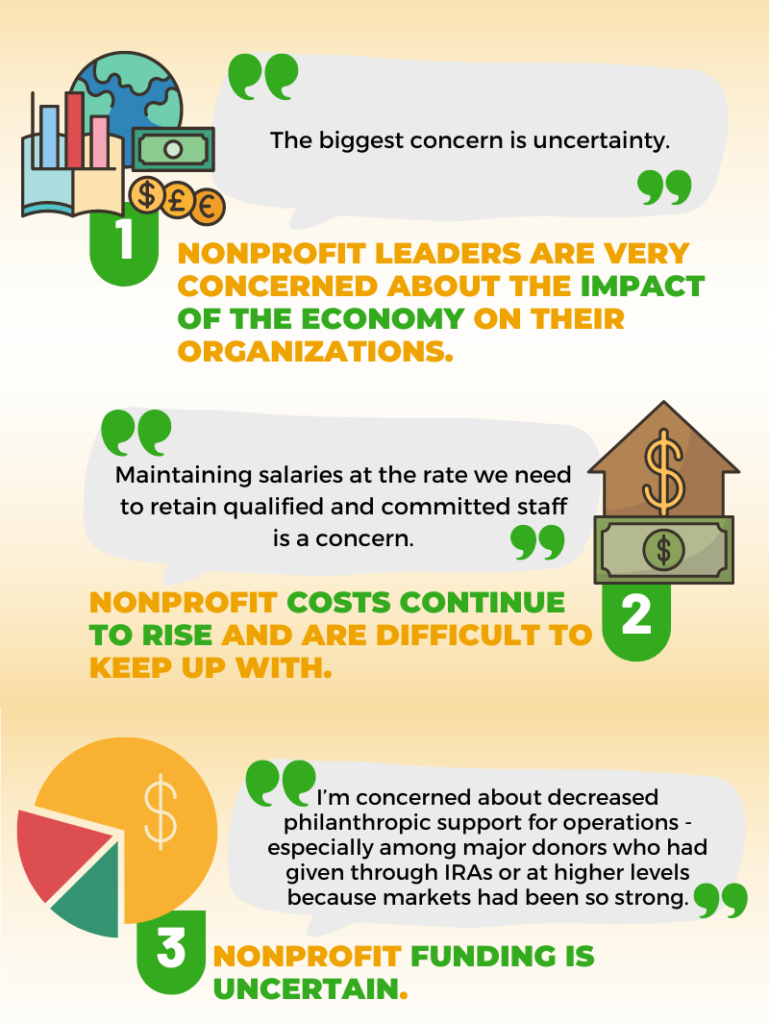2023 Forecast: Uncertain Future Amid Inflation and a Potential Recession
La Piana recently surveyed leaders from 35 nonprofit organizations across the country to get a better sense of how the current economy is impacting their work. There was an astonishing level of agreement on the top concerns these leaders face, with the headline: they anticipate less stable funding while costs are significantly rising. The impact of this reality, without adequate foresight, could be highly destabilizing. Read more about what we learned and tips to address the impact of the economy on your nonprofit.

1. Nonprofit leaders are very concerned about the impact of the economy on their organizations.
91% of the organizational leaders we surveyed are concerned about the economy, and 80% think the economy will have a major impact on their organization’s operations within the next year.
2. Nonprofit costs continue to rise and are difficult to keep up with.
Unfortunately, a quarter of leaders also feel extremely or somewhat fragile about their organizations’ ability to cope with a weaker economy in 2023. Overall, concerns about rising costs fit into two categories – staff and operations. Leaders expressed concern about the rising cost of living, inflation, and the impact of rising housing costs on staff. In many cases, staff are resigning. Bringing on qualified replacements has proven to be incredibly challenging. Staff shortages are then leading to higher levels of burnout, and this cyclical difficulty has been challenging to get ahead of. Across the nonprofit sector, staff are being paid higher salaries and benefits. Over 60% of the participating organizational leaders have already raised staff pay and an additional 31% anticipate doing so in the very near future. The challenge leaders now face is keeping up with the rising cost of living when facing uncertain funding. Unfortunately, 6% of respondents have already had to make staff reductions to balance their budgets, and an additional 43% are contemplating doing the same.
Nearly half of surveyed leaders are anticipating significantly higher costs and over 30% anticipate major negative impacts on current operations in the coming year. And yet, less than 20% of leaders anticipate an increase in revenue in 2023. Leaders fear they may not be able to meet the increasing needs of their communities. To address rising costs, they are making reductions wherever possible, including in the scope of services offered. Some are increasing prices to enhance earned income, while others are contemplating giving up formal offices and going fully remote, using fewer freelancers, deferring planned maintenance, delaying projects, and delaying hiring of new positions.
“I’m worried about staffing shortages, the inability to keep up with inflation on grant dollars, a decrease in donations due to the market recession, and volunteers not feeling available due to financial stress.”
3. Nonprofit funding is uncertain.
93% of surveyed leaders expect a decrease in funding due to the state of the economy. An additional 63% of respondents have increased their fundraising efforts while 30% are contemplating doing the same. Over the course of the last few years, some nonprofits experienced an increase in large one-time funding opportunities that significantly and positively impacted the sector. The concern for these organizations this time last year was about the sustainability of this increase in funding. What we are seeing now is sustainability moving to center stage.
“All our costs are increasing, but generally our funding does not increase at the same rate. We are expecting increases to cover program costs, but not Admin costs which puts us in a weak position operationally.”
While these findings are disheartening, they are not unexpected. In many cases, with innovative thinking, leaders can weather the storm of an uncertain economy. In fact, many nonprofit leaders have already done so, back in the last downturn in 2008, and the dotcom burst of 2000. In order to moderate both rising costs and lessening funding, organizations should consider the following strategies. None are new, all are tried and tested.
- Double down on every funding source – this includes earned income, diversifying donor bases, seeking operational grants, and diversifying funding sources so your organization is not overly reliant on too few funding sources. This is also the time to invest in your development function, even with belt-tightening ahead. If you have earned income, consider ways to grow your revenue, increase the higher end of your payor mix, or add premium-priced services.
- Increase communication and cultivate relationships with donors – and don’t always ask for money. Donors can be engaged and cultivated via programs, communications, and more. Keeping donors updated both on the organization’s financial needs and the increased needs of clients (which may likely be related to strain of economic downturn) helps them feel a part of the struggle, brings them closer to the work, and will yield larger gifts in the long run.
- Postpone optional new expenditures such as equipment, space, additional staff, or tech upgrades, if possible. Foregoing these improvements will increase stress on your team in the short run so explain why these delays are necessary. Engage staff in brainstorming additional cost-saving measures.
- Balance the compensation needs of staff with your ability to sustain a higher payroll. Offering a smaller COLA now, one that you know you can sustain, may be a wiser option than a larger increase today that may require layoffs in a year. This can also be accomplished by providing more flexibility for staff in other ways (e.g. more remote work options, stronger benefits, etc.).
- Think long term – where do you want to be in 18-24 months? What steps are necessary to get you there? Fundraising, often because cycles take so long, should be about continuously growing the ecosystem of prospect donors/funders. Regardless of being in an economic downturn, think about how to expand your ecosystem and activate current supporters (such as board members, senior staff, etc.) to continuously grow the support for the organization.
A tough economy is nothing new to the nonprofit sector. Even in good economic times, many organizations struggle. While we all hope 2023 brings, at worst, a mild recession from which we quickly recover, it is wise to balance that optimism with a more cautious financial strategy than has been necessary for many organizations over the past few years.
“We are expanding in ways that has amazed me”
The nonprofit sector is adaptable and innovative. We have seen nonprofit organizations find ways to show up during previous economic challenges, the COVID pandemic, increasing socio political unrest and divisiveness, racial reckoning, and respond to a call for increased levels of support for staff well-being. The additional challenge for nonprofits during periods of economic uncertainty, perhaps more so than in other industries, is the worry that needs will go unmet due to rising costs of services. This dilemma can be exhausting for a sector of people who throw their whole hearts into their work. The focus of this blog is on results from a survey on the topic of economic uncertainty, but we would be remiss to not also mention the impacts that the current economic situation also has on organizational culture and staff well-being. So, as we welcome a new year, and while nonprofit leaders focus on adopting some of the tips laid out above, continue to make space for strengthening organizational culture and making sure organizational leaders and staff are supported. For tips on how to do so, please see the following resources.


Amazing analysis. Expanding promotional services to your donors also helps. Help them look good, doing good.